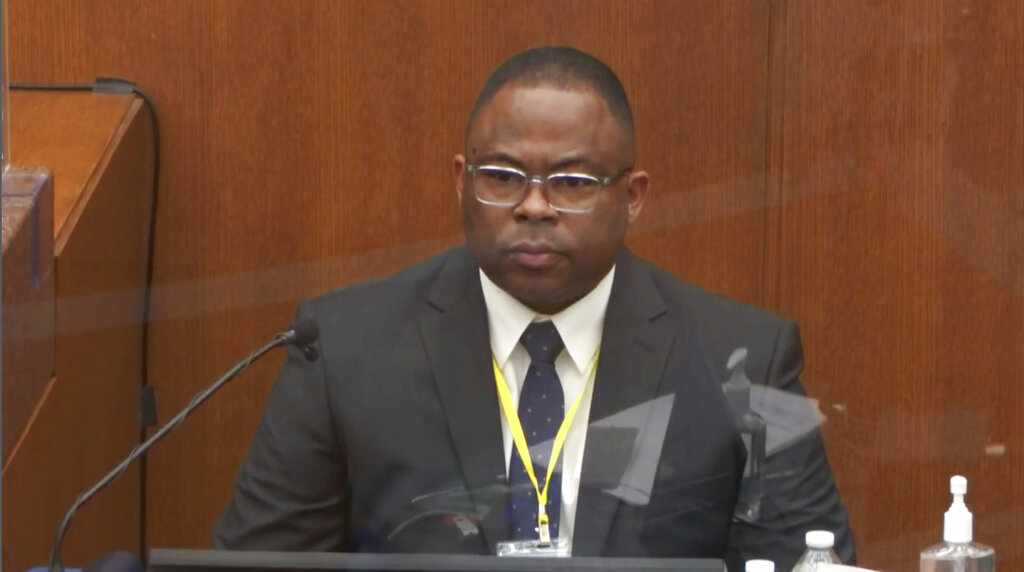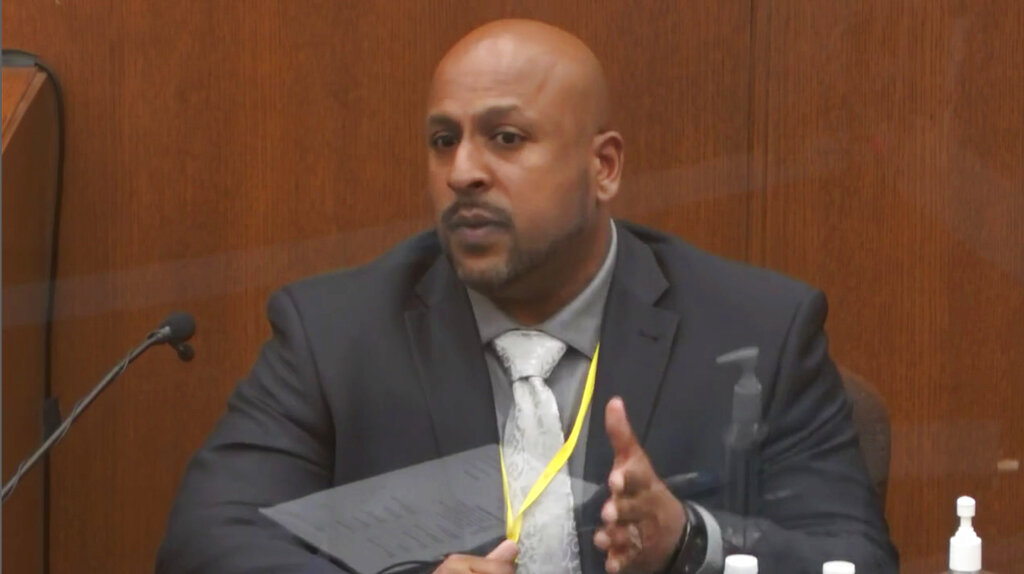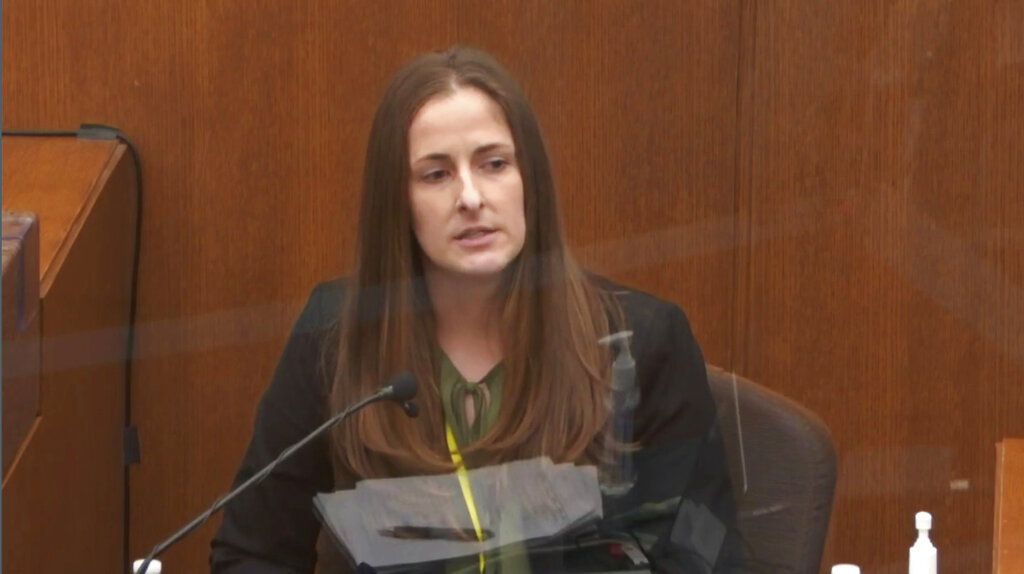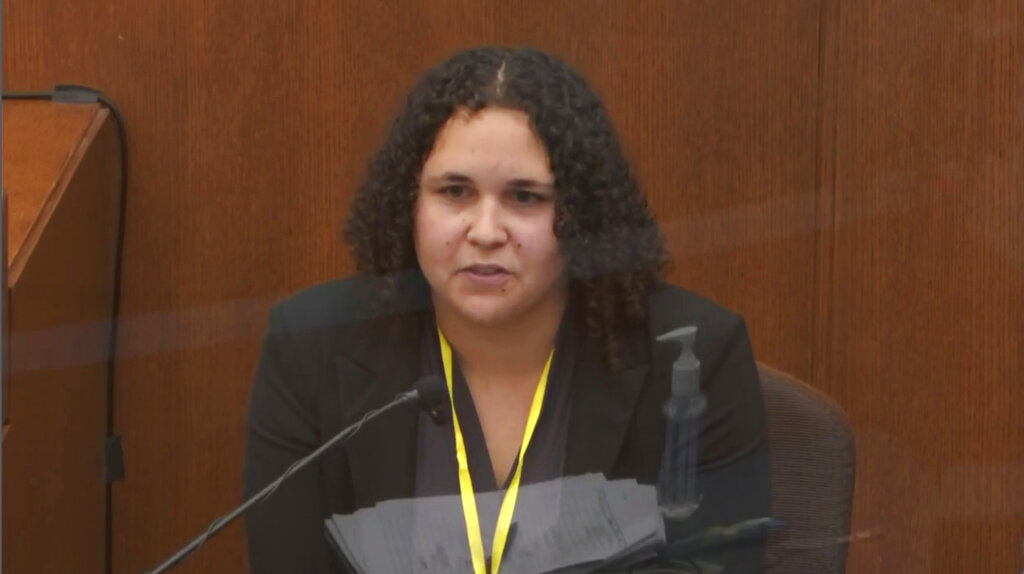MINNEAPOLIS (NewsNation Now) — The trial of former Minneapolis police officer Derek Chauvin charged in the death of George Floyd Wednesday included testimony from police officials, including an expert on use-of-force and a special agent investigating the arrest.
NewsNation will provide live coverage of the trial online and the NewsNation Now app.
Los Angeles Police Sgt. Jody Stiger
Los Angeles Police Sgt. Jody Stiger, a prosecution witness with expert knowledge of use-of-force, returned to the stand on the eighth day of trial, testifying on pain compliance technique and reasonable force.
Stiger testified that using pain compliance techniques during a restraint period when there is no threat to officers is “just pain,” and that “no force should have been used” once George Floyd was in the prone position.
Prosecutor Steve Schleicher showed jurors a composite image of five photos taken from various videos of the arrest. Stiger went through each photo, saying it appeared Chauvin’s left knee was on Floyd’s neck or neck area in each one.
“That particular force did not change during the entire restraint period?” Schleicher asked.

“Correct,” Stiger replied.
Stiger also said Chauvin squeezed Floyd’s fingers and pulled one of his wrists toward his handcuffs, a technique that uses pain to get someone to comply, but did not appear to let up while Floyd was restrained.
“Then at that point it’s just pain,” Stiger said.
Based on his review of video evidence, Stiger said Chauvin’s knee was on Floyd’s neck from the time officers put Floyd on the ground until paramedics arrived — about 9 1/2 minutes, by prosecutors’ reckoning.
His assessment came a day after Chauvin attorney Eric Nelson sought to point out moments in the video footage when, he said, Chauvin’s knee did not appear to be on Floyd’s neck.
Nelson also has suggested that bystanders who were yelling at Chauvin to get off Floyd distracted the officers, who perceived the onlookers as an increasingly hostile crowd.
But Stiger told Schleicher, “I did not perceive them as being a threat,” even though some onlookers were name-calling and using foul language. He added that most of the yelling was due to “their concern for Mr. Floyd.”
“My opinion was that no force was reasonable in that position,” Stiger testified. “The pressure … caused by the body weight could cause positional asphyxia and could cause death.”
During cross-examination, Nelson noted that dispatchers had described Floyd as between 6 feet and 6-foot-6 and possibly under the influence. Stiger agreed it was reasonable for Chauvin to come to the scene with a heightened sense of awareness.
Stiger also agreed with Nelson that an officer’s actions must be viewed from the point of view of a reasonable officer on the scene, not in hindsight.
Stiger began his testimony Tuesday, when he said officers were justified in using force while Floyd was resisting their efforts to put him in a squad car. But once he was on the ground and stopped resisting, “at that point, the officers … should have slowed down or stopped their force as well.”
Stiger said that after reviewing video of the arrest, “my opinion was that the force was excessive.”
Nelson has argued that Chauvin “did exactly what he had been trained to do over his 19-year career” and that it was Floyd’s use of illegal drugs and his underlying health conditions — not the officer’s knee — that killed him.
SR. SPECIAL AGENT James Reyerson

The second witness called by the prosecution Wednesday, senior special agent James Reyerson of the Minnesota Bureau of Criminal Apprehension, is part of a newly formed use-of-force investigation group.
Reyerson was the lead agent investigating the use-of-force in the Floyd arrest.
He said on the night of the incident he was called to Minneapolis City Hall where he began to collect evidence and photograph Chauvin.
Part of Reyerson’s testimony involved the investigation of the police squad car and Floyd’s Mercedes Benz vehicle.
Reyerson testified that six months after the incident, Chauvin’s lawyers re-examined the police car and found what was later determined to be pills that had Floyd’s DNA on them. During their opening statement in the trial, Chauvin’s defense said the pills contained methamphetamine with fentanyl.
Prosecutors stopped and started videos during the testimony from Reyerson, in an attempt to show the jury how long Chauvin held his position. Reyerson testified that Chauvin’s knee was on Floyd’s neck for two minutes after Floyd stopped talking, and for two minutes after Floyd ceased moving.
Nelson showed Reyerson a video of the incident and asked whether it appeared that Chauvin had his knee on Floyd’s back or neck.
“From what I see here, it was Mr. Chauvin’s shin that was compressed into the arm and the knee was actually on the back,” Reyerson said.
Reyerson agreed with Nelson that on one video of the incident it sounded as if Floyd said he “ate too many drugs.” But later during more questioning from the prosecution, Reyerson agreed that it sounded as if Floyd said “I ain’t do no drugs” in the video.
In other testimony, Reyerson agreed with Nelson that Floyd seemed to say in a police body-camera video of his arrest, “I ate too many drugs.”
Minnesota BCA Agent McKenzie Anderson
Minnesota Bureau of Criminal Apprehension Agent Mckenzie Anderson was the third witness called by the prosecution Wednesday afternoon.
Anderson said she was called to the area around Cup Foods after the incident. She testified she searched Floyd’s car for suboxone, which is used by opioid addicts to suppress cravings. She described collecting pills from the vehicles over the course of the investigation, including whole and partial tablets from the police squad car.
Anderson testified that Floyd’s blood was found in the back of the squad car and that pills found in the vehicle had saliva that matched Floyd’s DNA.

Forensic Scientist Breahna Giles
Breahna Giles, a state forensic scientist, testified Wednesday that pills found in the SUV Floyd was driving contained methamphetamine and fentanyl. Remnants of pills discovered in the back of the squad car also were found to contain methamphetamine. Earlier testimony revealed that one of those pills contained DNA from Floyd’s saliva.

Forensic Chemist Susan Meith
Forensic chemist Susan Meith was the last witness to testify on Wednesday.
Meith testified that remnants of a pill found in the back of the police squad car also contained methamphetamine and fentanyl. Earlier testimony from Anderson revealed that this pill contained DNA from Floyd’s saliva.

On Tuesday, prosecutors presented a series of witnesses in a bid to show that the former Minneapolis police officer disregarded his training when he knelt on Floyd’s neck for more than nine minutes.
Lieutenant Johnny Mercil, who teaches the proper use of force for the department, told jurors the neck restraint applied by Chauvin during the deadly arrest of Floyd was unauthorized. Officers are trained to use the least amount of force necessary to subdue a suspect, he said.
Two department trainers in crisis intervention and first aid also took the stand to describe what they characterized as extensive and continuing training that Minneapolis police officers receive.
Before the jury was brought into the courtroom in Tuesday morning, Hennepin County District Judge Peter Cahill heard arguments on a request by a friend of Floyd to quash a prosecution subpoena for him to testify.
Morries Hall was in the car with Floyd when police arrived. Hall has said he would invoke his constitutional right against self-incrimination if he had to appear on the witness stand.
Cahill decided that most questions Nelson wanted to ask could incriminate Hall. Even so, the judge said Hall should be able to testify on Floyd’s condition in the car and whether he fell asleep suddenly after possibly taking opioid pills. Cahill gave Nelson until Thursday to draft potential questions.
Chauvin has pleaded not guilty to murder and manslaughter charges for Floyd’s arrest, which happened on suspicion that Floyd used a fake $20 bill to buy cigarettes on May 25, 2020.
The Associated Press and Reuters contributed to this report. Reporting by Jonathan Allen and Brendan O’Brien of Reuters. Reporting by Amy Forliti, Steve Karnowski and Tammy Webber of AP.
